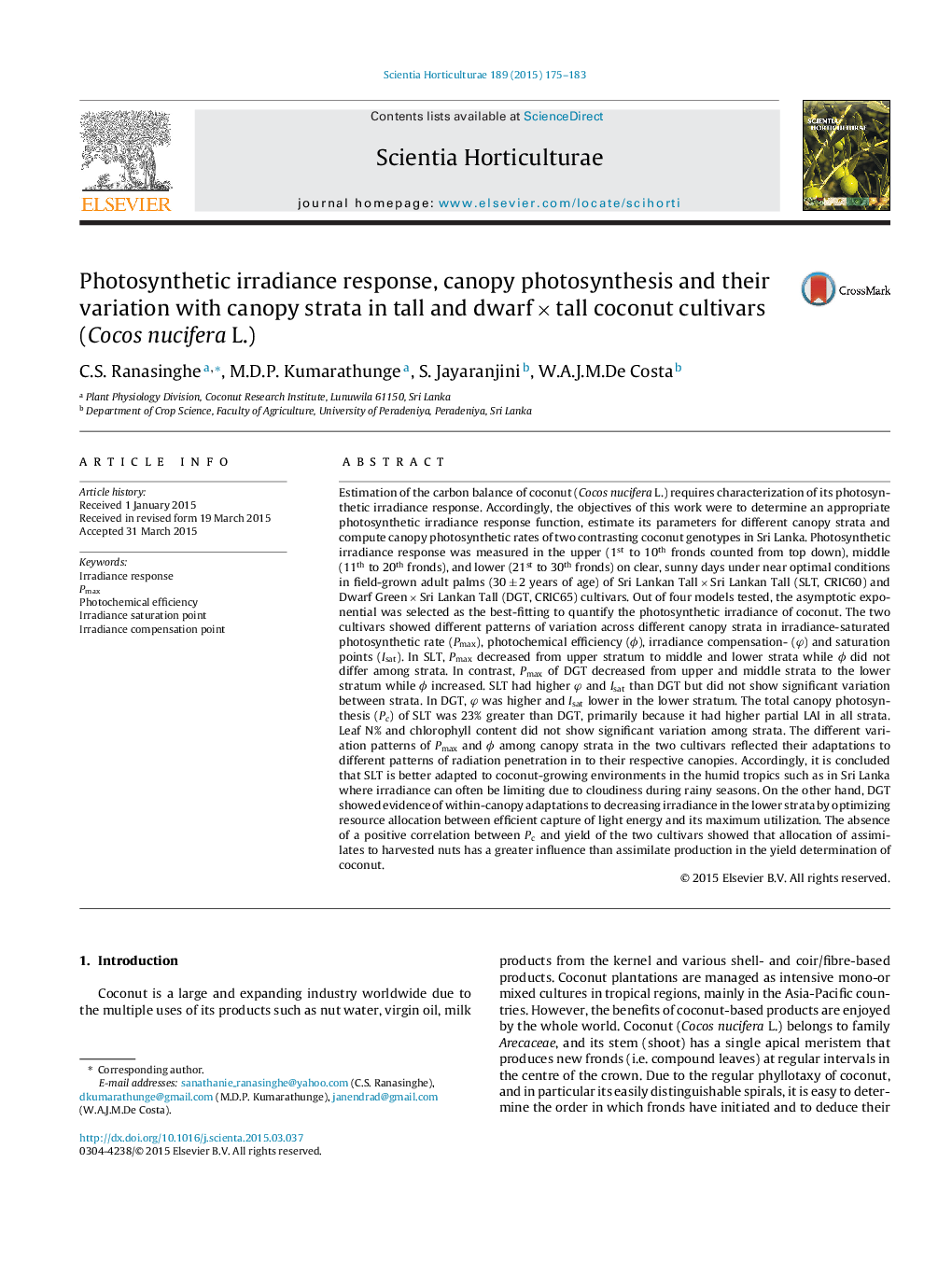| کد مقاله | کد نشریه | سال انتشار | مقاله انگلیسی | نسخه تمام متن |
|---|---|---|---|---|
| 6407050 | 1628809 | 2015 | 9 صفحه PDF | دانلود رایگان |
عنوان انگلیسی مقاله ISI
Photosynthetic irradiance response, canopy photosynthesis and their variation with canopy strata in tall and dwarf Ã tall coconut cultivars (Cocos nucifera L.)
دانلود مقاله + سفارش ترجمه
دانلود مقاله ISI انگلیسی
رایگان برای ایرانیان
موضوعات مرتبط
علوم زیستی و بیوفناوری
علوم کشاورزی و بیولوژیک
دانش باغداری
پیش نمایش صفحه اول مقاله

چکیده انگلیسی
Estimation of the carbon balance of coconut (Cocos nucifera L.) requires characterization of its photosynthetic irradiance response. Accordingly, the objectives of this work were to determine an appropriate photosynthetic irradiance response function, estimate its parameters for different canopy strata and compute canopy photosynthetic rates of two contrasting coconut genotypes in Sri Lanka. Photosynthetic irradiance response was measured in the upper (1st to 10th fronds counted from top down), middle (11th to 20th fronds), and lower (21st to 30th fronds) on clear, sunny days under near optimal conditions in field-grown adult palms (30 ± 2 years of age) of Sri Lankan Tall Ã Sri Lankan Tall (SLT, CRIC60) and Dwarf Green Ã Sri Lankan Tall (DGT, CRIC65) cultivars. Out of four models tested, the asymptotic exponential was selected as the best-fitting to quantify the photosynthetic irradiance of coconut. The two cultivars showed different patterns of variation across different canopy strata in irradiance-saturated photosynthetic rate (Pmax), photochemical efficiency (Ï), irradiance compensation- (Ï) and saturation points (Isat). In SLT, Pmax decreased from upper stratum to middle and lower strata while Ï did not differ among strata. In contrast, Pmax of DGT decreased from upper and middle strata to the lower stratum while Ï increased. SLT had higher Ï and Isat than DGT but did not show significant variation between strata. In DGT, Ï was higher and Isat lower in the lower stratum. The total canopy photosynthesis (Pc) of SLT was 23% greater than DGT, primarily because it had higher partial LAI in all strata. Leaf N% and chlorophyll content did not show significant variation among strata. The different variation patterns of Pmax and Ï among canopy strata in the two cultivars reflected their adaptations to different patterns of radiation penetration in to their respective canopies. Accordingly, it is concluded that SLT is better adapted to coconut-growing environments in the humid tropics such as in Sri Lanka where irradiance can often be limiting due to cloudiness during rainy seasons. On the other hand, DGT showed evidence of within-canopy adaptations to decreasing irradiance in the lower strata by optimizing resource allocation between efficient capture of light energy and its maximum utilization. The absence of a positive correlation between Pc and yield of the two cultivars showed that allocation of assimilates to harvested nuts has a greater influence than assimilate production in the yield determination of coconut.
ناشر
Database: Elsevier - ScienceDirect (ساینس دایرکت)
Journal: Scientia Horticulturae - Volume 189, 25 June 2015, Pages 175-183
Journal: Scientia Horticulturae - Volume 189, 25 June 2015, Pages 175-183
نویسندگان
C.S. Ranasinghe, M.D.P. Kumarathunge, S. Jayaranjini, W.A.J.M.De Costa,